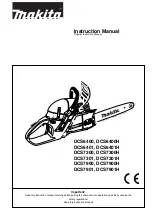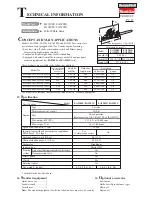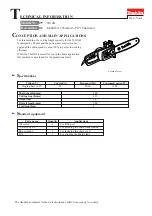
18
SAW CHAIN
WARNING
It is very important for smooth and safe operation to keep the cutters always sharp.
Your cutters need to be sharpened when
Sawdust becomes powder-like.
You need extra force to saw in.
The cut way does not go straight.
Vibration increases.
Fuel consumption increases.
Cutter setting standards:
WARNING: Be sure to wear safety gloves.
Before filing:
Make sure the saw chain is held securely (Fig.24).
Make sure the engine is stopped.
Use a round file of proper size for your chain.
Chain type: K2
File size: 3/16 in (4.76mm)
Place your file on the cutter and push straight forward. Keep the file position as illustrated
(Fig.25)
After every cutter has been set, check the depth gauge and file it to the proper level as
illustrated (Fig.26).
WARNING: Be sure to round off the front edge to reduce the chance of kickback or tie-strap
breakage.
Make sure every cutter has the same length and edge angles as illustrated (Fig.26).
Referring to figure 26:
(1) Appropriate gauge checker.
(2) Make the shoulder round
(3) Depth gauge standard
(4) Cutter length
(5) Filing angle
(6) Side plate angle
(7) Top plate cutting angle
GUIDE BAR
Reverse the bar occasionally to prevent partial wear.
The bar rail should always be a square. Check for wear of the bar rail. Apply a ruler to the bar
and the outside of a cutter. If a gap is observed between them, the rail is normal. Otherwise ,
the bar rail is worn. A worn bar needs to be repaired or replaced (Fig.27).
Referring to figure 27:
1. Ruler
2. Gap
3. No gap
4. Chain tilts
GENERAL CLEANING
Always remove wood shavings and oil from the chain saw after use. Clean the chain saw
by brushing away dirt and waste residue that may be caught the machine. Wipe the
chainsaw clean with a damp cloth or hand brush. DO NOT use running water, solvents,
strong detergents or a high pressure washer to clean. (Use a mild detergent and sponge
to clean the plastic surfaces.)
Pay particular attention to the air intake area, keeping it free of debris.






































